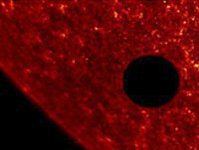Venus to create moving beauty mark on the sun
Stargazers around the world are setting up special telescopes and passing out cardboard eclipse glasses to view the once-in-a-lifetime celestial cameo of Venus passing in front of the sun.
The transit of Venus - a planetary spectacle that won't occur again until 2117 - won't be enough to significantly block the sun's light but it will give Earth's closest star a moving beauty mark. Venus is Earth's second-closest neighboring planet.
"In terms of rarity, to be here at a time when it's happening, you almost have to look at it," said Geoff Chester of the U.S. Naval Observatory, who saw the last transit in 2004. "It ain't going to happen again in my lifetime", says Washington Post.

Astrologers consider Venus, similar to the Earth in size, weight and gravity, to be one of the most important planets, and this event is being closely watched. "On the surface of it, together the Sun and Venus mean something very successful and powerful, but on this occasion they might just SAVE THE PLANET!" said British astrologer Alison Chester Lambert. She pointed out that previous Venus transits had taken place during times of revolution and upheaval, "We are heading for a Spiritual Revolution by the looks of it."
Opthalmological associations have issued reminders of the dangers of looking straight into the sun. As with eclipses, it is extremely dangerous to observe this phenomenon directly without eye protection. The best ways of looking at the transit are indirectly using a pinhole camera or with professional eye protection such as high strength welder's goggles or a telescope fitted with a proper filter, according to Social Media SEO.
Groups of scientists from the University of North Texas planned to watch from points in Alaska and Hawaii to recreate the 1769 expedition of British Capt. James Cook, who used the transit to calculate Earth's distance from the sun. The scientists will use atomic clocks, GPS and high-end telescopes to take measurements, and will use high-end video gear to capture time-lapse video.
This will be the seventh transit visible since German astronomer Johannes Kepler first predicted the phenomenon in the 17th century. Because of the shape and speed of Venus' orbit around the sun and its relationship to Earth's annual trip, transits occur in pairs separated by more than a century.
It's nowhere near as dramatic and awe-inspiring as a total solar eclipse, which sweeps a shadow across the Earth, but there will be six more of those this decade, informs Daily Journal.
Subscribe to Pravda.Ru Telegram channel, Facebook, RSS!


